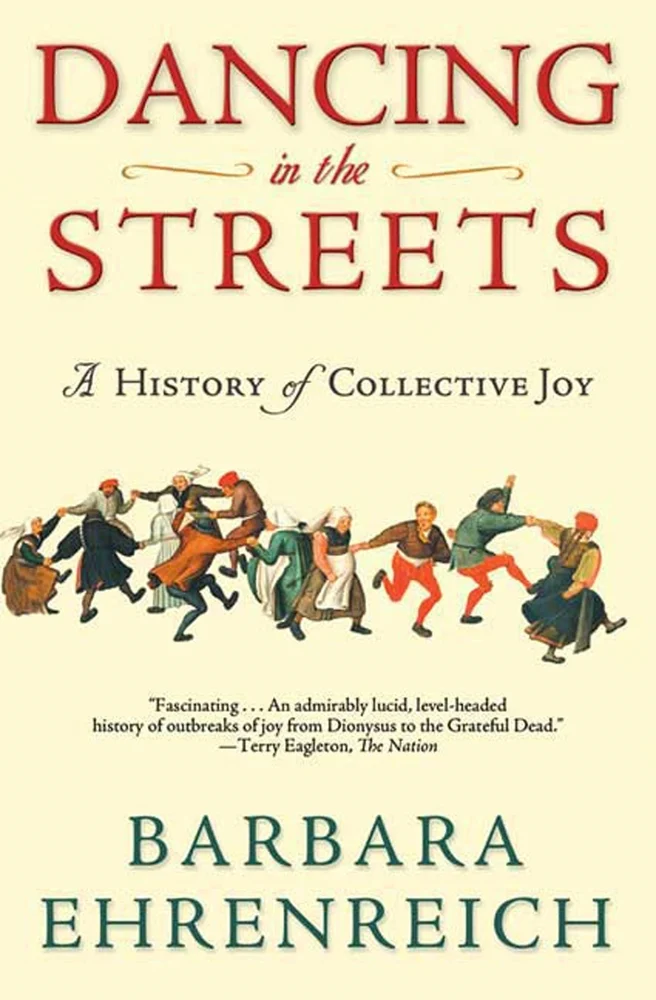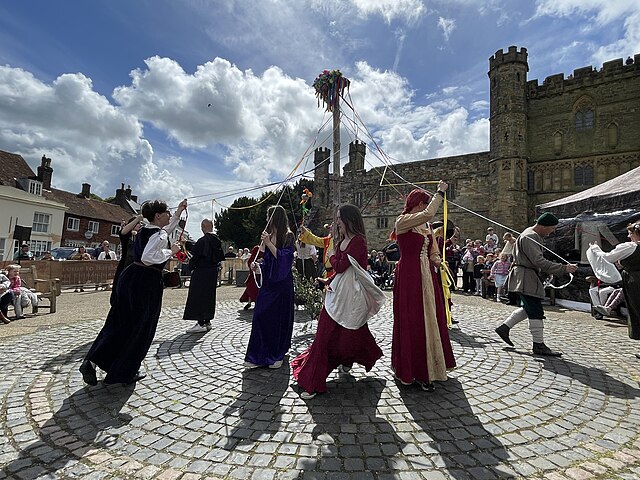In Dancing in the Streets: A History of Collective Joy, Barbara Ehrenreich makes the case that communal celebration can provide release, solidarity, and spiritual medicine in the darkest of times. Throughout history, people have come together to conduct rituals, explore identity, and dance until they couldn’t dance anymore. While the exact function of these gatherings has changed across time and place, the ability of collective joy to build connection and fortify communities against hardship has remained—just as efforts from the powerful to suppress that joy have also persisted.
provide release, solidarity, and spiritual medicine in the darkest of times. Throughout history, people have come together to conduct rituals, explore identity, and dance until they couldn’t dance anymore. While the exact function of these gatherings has changed across time and place, the ability of collective joy to build connection and fortify communities against hardship has remained—just as efforts from the powerful to suppress that joy have also persisted.
Shakespeare may not have had a smartphone in his pocket, but he was certainly aware of the colossal challenges of his time, as well as the ways in which public celebration can operate as a salve for grief and despair. Despite the trials of plague, censorship, and political unrest outside his window—and personal losses in his own family—he persisted in building a prolific writing career that brought people together for the sole purpose of entertainment and joy. He also wrote communal joy into his stories—not just as frivolity, but as social glue, healing, and resistance. Let’s take a closer look at how Shakespeare tapped into the human need for gathering and celebration through his plays, and how literature and performance can model how to survive adversity—together.
Shakespeare’s World: Crisis and Celebration
By Shakespeare’s time, the shape of collective joy had already changed drastically from the rituals of ancient Europe. Describing the shift that occurred in the late medieval period, Ehrenreich writes, “People once danced, drank, feasted, and performed dramas and burlesques within their churches; now they did so outside those churches in the festivities that still clung to, and surrounded, each holy day” (93). By the Early Modern era, the once feast-laden church calendar was now only dotted with quiet communion rituals featuring sips of wine and mere morsels of bread. As raucous gatherings were pushed out of the church, people became even more committed to creating space for enthusiastic celebration and play through public carnivals.
Despite this drive to gather, Shakespeare’s England was not a time of social cohesion. The Protestant-Catholic divide, severe wealth disparity, and potential crises of succession created a lingering sense of foreboding. Regular plague outbreaks led to playhouse closures and quarantines, often making social gatherings impossible. Even when the plague was dormant and people were able to scrape together the funds for revelry, strict censorship and surveillance attempted to suppress art and celebration at every turn.
Similar circumstances made public celebration difficult throughout Europe. And yet, people gathered. Plays were performed. May Day and other carnivalesque festivals rooted in pagan traditions persisted. As Ehrenreich notes, collective joy was often suppressed by elites—but it never disappeared. Referencing an incident in France when the bishop of Fréjus attempted to shut down the Feast of Fools, Ehrenreich describes how the people rioted and stormed the bishop’s palace, writing, “Festivity—like bread or freedom—can be a social good worth fighting for” (94). Shakespeare echoed this belief by centering collective experiences as plot drivers in his plays.
Collective Joy as Escape
Shakespeare’s classic comedies are full of festivals, transformations, and joyful confusion. In plays like A Midsummer Night’s  Dream, As You Like It, and Much Ado About Nothing, lovers flee the court, order dissolves in the forest, and identities are blurred—mirroring the function of carnival and ritual throughout history. Ehrenreich writes, “Whatever social category you had been boxed into—male or female, rich or poor—carnival was a chance to escape from it.” (88)
Dream, As You Like It, and Much Ado About Nothing, lovers flee the court, order dissolves in the forest, and identities are blurred—mirroring the function of carnival and ritual throughout history. Ehrenreich writes, “Whatever social category you had been boxed into—male or female, rich or poor—carnival was a chance to escape from it.” (88)
For Shakespeare, theater served as a similar vehicle—a place where characters play with gender, class, and even non-human identities. The forest in Midsummer becomes a space of release and playful chaos where the characters magically transform, all while experiencing a kind of collective catharsis. At a time when the concept of the self was shifting drastically, Shakespeare and his contemporaries provided a container to explore what it means to perform identity. “Within the theater,” Ehrenreich writes, “there is a fascination with plots involving further deceptions: Shakespeare’s Portia pretends to be a doctor of law; Rosalind disguises herself as a boy; Juliet feigns her own death” (139). Shakespeare’s theater was itself a kind of magical forest—a liminal space where folks gathered to become something outside themselves.
Collective Resistance and Recovery
Even in Shakespeare's histories and tragedies, we see instances of collective passion and attempts to suppress it. In the opening scene of Julius Caesar, we find Romans celebrating the return of their leader. Joy and excitement mingle with unrest as two government officials chastise the commoners for their revelry, fearing that Caesar is stirring up undeserved political passion.
In historical Rome, gathering crowds were met with similar suspicions. Ehrenreich recounts the time when emperor Trajan refused a request from a governor to form a local fire department, writing, “‘if people assemble for a common purpose, whatever name we give them and for whatever purpose, they soon turn into a political club’” (52). Later in the play, Marc Antony harnesses this human tendency by turning collective grief into political action. Ehrenreich writes extensively about the ways in which collective emotion—be it joy, sorrow, ecstasy, or rage—builds power and solidarity that threaten the status quo. Describing the "leveling effect” of these gatherings, she says, “From an elite perspective, there is one inherent problem…the way in which they dissolve rank and other forms of social difference” (44). Shakespeare uses the crowd as a dynamic character of its own, modeling how the collective can shape the course of history.
What We Can Learn
Studying Shakespeare reminds us that the classroom can also be a place for collective joy. Through discussion, performance, and play, students can find relief from modern stressors. Centering celebration as a theme for further analysis allows students to explore how celebration and communal experiences show up in their own lives, prompting them to consider the ways in which technology may be interfering with their ability to authentically connect. For educators, collective joy, whether onstage or in a classroom, is not just a celebration—it’s a way to remind ourselves and our students that we’re not alone. As Ehrenreich asserts, “The capacity for collective joy is encoded into us…We can live without it, as most of us do, but only at the risk of succumbing to the solitary nightmare of depression. Why not reclaim our distinctively human heritage as creatures who can generate their own ecstatic pleasures out of music, color, feasting, and dance?” (260)










